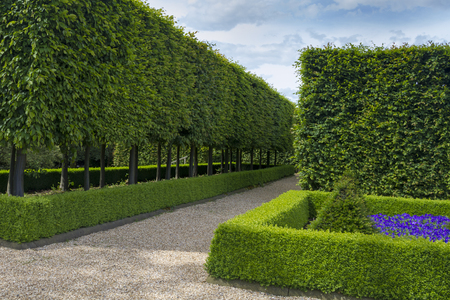1. Understanding the Unique Charm of British Gardens
There is something undeniably special about a traditional British garden—a blend of cultivated elegance and natural charm that has been cherished for generations. From the gentle curves of herbaceous borders to the time-worn beauty of stone pathways and the welcoming shade beneath mature trees, British gardens exude a sense of tranquillity and history. Classic features such as clipped box hedges, fragrant rose beds, and well-tended lawns provide a backdrop where every season brings its own palette of colours and textures. Outdoor lighting, when thoughtfully chosen and positioned, can enhance these beloved elements without detracting from their timeless appeal. Whether you are highlighting the sculptural form of an old apple tree, drawing attention to a weathered bench, or simply creating a warm ambience for evening gatherings, good lighting becomes an integral part of the landscape. It not only extends the enjoyment of your garden after dusk but also complements the classic atmosphere that makes British gardens so unique. With careful planning, lighting can reveal hidden corners, create inviting pathways, and evoke memories of long summer evenings—ensuring your outdoor space remains both functional and enchanting throughout the year.
Essential Types of Garden Lighting
When it comes to transforming your British garden into a welcoming haven after dusk, choosing the right lighting is essential. Here in the UK, practicality often goes hand-in-hand with charm and a touch of whimsy. Whether you want to create a cosy nook for evening tea or safely illuminate winding paths, several popular options are well-suited to our climate and lifestyle.
Popular Lighting Options for British Gardens
| Lighting Type | Best Suited For | Key Benefits |
|---|---|---|
| Fairy Lights | Patios, Trees, Fences | Adds magical ambiance, flexible placement, low energy use |
| Lanterns | Tabletops, Entrances, Pergolas | Traditional charm, portable, available in electric or candle-lit styles |
| Solar-Powered Lamps | Borders, Pathways, Driveways | Energy-efficient, automatic operation, minimal maintenance |
Fairy Lights: A British Favourite for Cosy Evenings
No garden party or summer evening is complete without the warm glow of fairy lights strung along fences or wound through tree branches. They’re especially popular across Britain for their ability to turn even the smallest patio into an enchanting retreat. Battery-powered or solar versions are both widely available, making them practical as well as decorative.
Lanterns: Blending Tradition with Practicality
For those who appreciate a classic look, lanterns evoke nostalgia and bring a sense of timelessness to your outdoor space. Whether hung from hooks or placed on tables, they offer gentle illumination that’s perfect for relaxed gatherings. In true British fashion, many opt for weather-resistant designs to withstand our unpredictable weather.
Solar-Powered Lamps: Sustainable and Sensible Choice
The shift towards sustainability is strong in the UK, making solar-powered lamps increasingly popular. These lamps harness daylight and automatically light up at dusk—ideal for illuminating borders and pathways without fiddly wiring or extra costs on your electricity bill. Their robust construction makes them suitable for British gardens year-round.
A Tip from Experience:
If you’re just starting out, mix and match these lighting types for different areas—fairy lights above seating zones, lanterns near entrances, and solar lamps along paths—to create a layered effect that’s both functional and atmospheric.
![]()
3. Best Practices for Outdoor Lighting Placement
When it comes to lighting up your British garden, placement is just as important as the type of fixtures you choose. A thoughtfully illuminated space not only elevates the atmosphere but also enhances safety and security—particularly crucial given our unpredictable British weather and often intricate garden layouts. First and foremost, pathways and steps should be your priority. Use low-level bollard lights or recessed step lights along paths and entrances to prevent trips and falls during those long winter evenings. For added security, position motion-sensor lights near gates, sheds, and garages—these are effective deterrents against unwanted visitors and provide peace of mind.
For ambience, consider where you naturally gather in the garden. Place warm-toned LED uplights beneath mature trees or shrubs to highlight their structure and create gentle shadows; this is especially charming on drizzly nights when foliage glistens with rain. Wall-mounted lanterns by patio doors or seating areas cast a welcoming glow without overwhelming the space. If you have a traditional British layout with winding borders or a sunken terrace, use spike spotlights to accentuate planting beds or architectural features like old stone walls.
Always factor in the ever-changing weather: select fixtures rated IP65 or above to withstand heavy rain and damp conditions. Keep cables tidy and well-protected—tucking them under gravel or along fences—to avoid hazards and maintain a neat appearance. By layering different light sources thoughtfully, youll strike the right balance between safety, security, and that quintessentially cosy British garden ambience.
4. Creating Seasonal Appeal
One of the true pleasures of a British garden is its changing character across the seasons. To keep your outdoor space inviting all year round, it’s essential to adapt your lighting scheme in tune with our unique UK daylight hours and seasonal weather. Here are some practical tips to ensure your garden remains both beautiful and functional from the shortest winter days to those lingering summer evenings.
Understanding Daylight Patterns in the UK
The length of daylight can vary dramatically in Britain. In winter, darkness falls as early as 3:30pm in some regions, while summer evenings can stay light until nearly 10pm. Adapting your lighting to these patterns ensures safety, comfort, and ambience whatever the month.
Adapting Lighting by Season
| Season | Lighting Tips | Recommended Fixtures |
|---|---|---|
| Winter | Create warmth and cosiness with soft, warm-white lights; focus on pathways and entrances for safety. | Lanterns, festoon lights, motion-sensor path lights |
| Spring | Highlight emerging blooms with subtle uplighting; consider solar-powered options as days lengthen. | Solar spike lights, spotlights under shrubs |
| Summer | Enhance entertaining areas for late gatherings; use dimmable lights for flexibility. | Pergola string lights, wall-mounted sconces, table lamps (outdoor-rated) |
| Autumn | Accentuate autumn foliage and garden structure; ensure paths are well-lit as nights draw in. | Bollard lights, adjustable uplights on trees or hedges |
Practical Tips for Year-Round Garden Lighting:
- Invest in Timers or Smart Controls: Automate your lighting to match shifting sunset times without constant adjustment.
- Layer Your Lighting: Combine functional task lighting with ambient features for a balanced look in every season.
- Choose Weatherproof Fixtures: British weather can be unpredictable—opt for fittings rated for outdoor use to withstand rain and frost.
- Embrace Flexibility: Portable lanterns and solar stakes can be moved around as needed, perfect for impromptu get-togethers or highlighting new garden growth.
- Sustainability Matters: LED bulbs and solar-powered options not only cut costs but are kinder to the environment—a value close to many British gardeners’ hearts.
No matter the time of year, thoughtful lighting choices will help you make the most of your outdoor haven—whether you’re enjoying a bracing winter cuppa beneath twinkling fairy lights or gathering friends for a balmy August barbecue long into the evening. By paying attention to our local daylight rhythms and embracing flexible solutions, your garden can shine through every season.
5. Energy Efficiency and Sustainability
When it comes to illuminating British gardens, the conversation increasingly turns towards energy efficiency and sustainability. More and more homeowners are recognising the importance of eco-friendly choices, not just for the sake of reducing utility bills but also for minimising environmental impact. Among the most popular options these days are solar lighting and LED bulbs, both offering impressive advantages tailored to the unique needs of gardens across the UK.
Solar lighting is particularly well-suited to British outdoor spaces. While our weather can be unpredictable, today’s solar lights are remarkably efficient, storing energy even on overcast days. They’re a doddle to install too—no wiring or complicated setup required. Simply place them where you fancy, and they’ll automatically illuminate paths, flower beds, or patios as dusk falls. It’s a hassle-free way to add ambience while keeping running costs at zero.
LED bulbs are another top choice for those looking to go green. Compared with traditional incandescent bulbs, LEDs use a fraction of the electricity and last considerably longer. This means fewer replacements and less waste—a win-win for both your wallet and the planet. Many garden lighting fixtures now come equipped with LED technology as standard, making it easier than ever to upgrade your current set-up without sacrificing style or brightness.
For those who want to take sustainability a step further, consider choosing lights made from recycled materials or those designed for easy recycling at end-of-life. Some British manufacturers are leading the way in producing robust, eco-conscious garden lighting that stands up to our ever-changing weather while treading lightly on the earth.
Incorporating these energy-efficient practices isn’t just about saving pennies; it’s about taking pride in nurturing both your garden and the environment. By opting for solar or LED solutions, you’re joining a growing community of Brits committed to sustainable living—one outdoor light at a time.
6. Common Pitfalls and How to Avoid Them
Even the most well-intentioned garden lighting projects in Britain can go awry if common mistakes aren’t recognised early on. Over the years, I’ve seen neighbours fall into similar traps time and again—here’s some practical advice, drawn from local experience, to help you sidestep them.
Overlighting: Less Is Often More
One of the most frequent errors is simply using too many lights or bulbs that are far too bright for a modest British garden. Not only does this drown out the gentle charm of your greenery, but it also contributes to light pollution—a growing concern in rural and suburban areas alike. Instead, aim for subtlety: choose warm white bulbs with lower wattages and position them thoughtfully to accentuate key features rather than flood the whole space.
Poor Placement and Glare
Placing lights at eye level or where they shine directly into windows is a surefire way to spoil an evening outdoors or annoy your neighbours. The trick is to install fixtures so that light is cast downwards or upwards onto plants, trees, or pathways—never straight across. Consider shielded fittings or spike lights nestled among borders for a soft, inviting effect without harsh glare.
Neglecting British Weather
Our famously unpredictable weather means outdoor electrics need extra attention. It’s all too easy to buy budget fittings that aren’t truly weatherproof, only for them to fail after one wet winter. Always check for robust IP ratings (IP65 or above) and corrosion-resistant materials such as stainless steel or powder-coated aluminium. And don’t forget: all external wiring should be properly protected and installed by a qualified electrician.
Ignoring Wildlife and Plant Growth
A classic oversight is failing to consider how lighting affects local wildlife—especially bats and birds—or how plants will grow over time. Choose timers or motion sensors so your lights aren’t on all night, disturbing nocturnal creatures. When planning placement, remember that what looks tidy now may be swallowed up by next season’s foliage; allow flexibility for adjustments as your garden matures.
Forgetting Ongoing Maintenance
Finally, many folks overlook the importance of regular upkeep. Leaves, mud, and insects can quickly dim even the best-designed scheme. Make checking and cleaning your fittings part of your seasonal gardening routine, just as you would with any cherished outdoor feature.
Avoiding these pitfalls requires a bit of thoughtfulness and a willingness to learn from those who have gone before you—a tradition deeply rooted in British gardening culture. With patience and care, you’ll enjoy a beautifully lit outdoor space that stands the test of time and weather.

